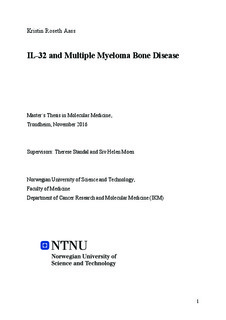| dc.description.abstract | Multiple myeloma is a malignancy of plasma cells characterized by multiple tumors in the bone marrow and progressive osteolytic bone disease. The bone lesions are caused by increased bone resorption by osteoclasts and decreased bone formation by osteoblasts. Recently, we found that myeloma cells obtained from bone marrow plasma had high copy number of IL-32, a novel interleukin that has not previously been related to multiple myeloma. Further investigation revealed that IL-32 was secreted by the myeloma cells bound to exosomes, indicating that the interleukin could influence the bone marrow microenvironment. Preliminary results from the group showed that rhIL-32 and even more potently, IL-32 in myeloma-derived exosomes, increased osteoclastogenesis, both in vitro and in vivo. Here, these findings were validated by treating primary monocytes with exosomes derived from IL-32 expressing- and IL-32 KO myeloma cells. Strikingly, number of osteoclasts in cultures was increased by treatment with IL-32-containing exosomes, while IL32 depleted exosomes did not increase osteoclastogenesis, which support that IL-32 may act as an inducer of osteoclast differentiation. The influence of IL-32 on osteoblasts was not previously studied, and therefore addressed in this thesis. We evaluated the effects of IL-32 on osteoblast differentiation from primary mesenchymal stromal/stem cells (MSCs). Our results indicate that IL-32 alone has no effect on osteoblast differentiation or proliferation. IL32 has previously been shown to upregulate CYP27B11, the enzyme that catalyze conversion of pro- to active vitamin D. We therefore hypothesized that IL-32 could influence osteoblasts by increasing CYP27B1 and thereby activate vitamin D-dependent signaling pathways in the cells. However, we found no clear evidence for effects of IL-32 in the presence of the pro form of vitamin D (25(OH)D3), evaluated by extent of various parameters of osteogenic differentiation. There was a tendency for increased biosynthesis of the active form of vitamin D, 1,25(OH)2D3 in response to IL-32, but an optimized protocol is needed to conclude on this matter. Furthermore, CYP27B1 mRNA was not upregulated in response to IL-32, but the mRNA detection levels were low, suggesting that CYP27B1 expression should be evaluated by other means. Finally, as our preliminary results showed that IL-32 is upregulated in myeloma cells in response to hypoxic conditions, we investigated the effects of hypoxia on MSCs. Interestingly, these cells were found to express IL-32, and the expression is increased by hypoxia and by stimulation with IL-32 itself, the latter suggesting an positive feedback loop between myeloma cells and MSCs in the bone marrow. Taken together, these findings contribute to an increased understanding of the role of IL-32 in multiple myeloma bone disease. However, more research is required to conclude on the role of IL-32 in osteoblasts and MSCs, as well as determining the cellular mechanisms behind IL-32 promoted osteoclastogenesis. | nb_NO |
